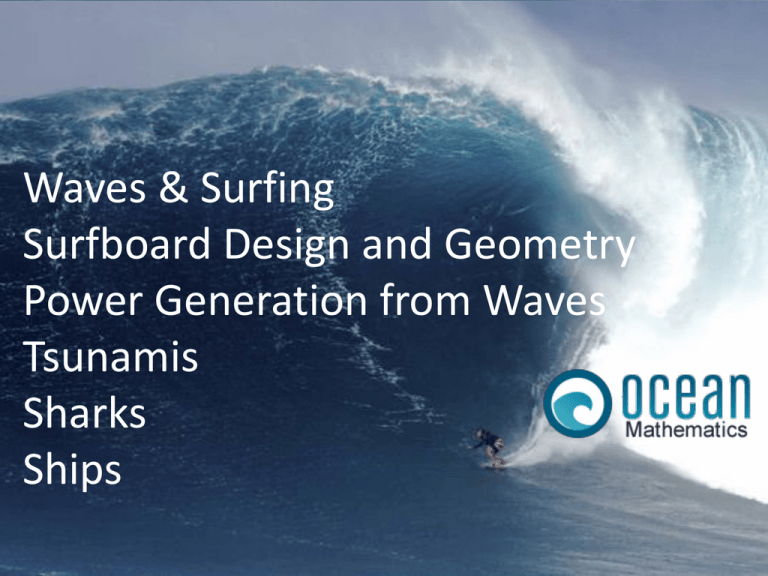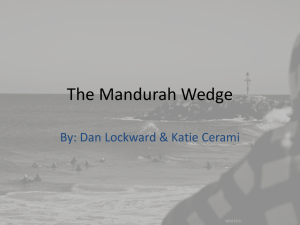Mathematics of Surfing - Passy`s World of Mathematics
advertisement

Waves & Surfing Surfboard Design and Geometry Power Generation from Waves Tsunamis Sharks Ships Paul Pascoe Mathematics of Surfing Image Purchased by Passy’s World from Dreamstime.com Intro Video Surfing Miscalculations and Random Events Source: http://www.youtube.com/watch?v=Fp5Ds_6ck5s Mathematics of Surfing What Causes Water Waves Predicting Large Waves Breaking Waves Wave Speed Equations Effect of Sea Floor Parts of a Breaking Wave Catching and Riding a Wave Artificial Surf Breaks What Causes Water Waves Image Source: http://www.culut.com When wind blows over the vast expanses of open water, it transfers energy to the water surface and creates water waves. Surf Waves come from Ocean Storms. What Causes Water Waves Wave Energy = Wind Speed x Wind Duration x Fetch Distance Image Source: http://www.seafriends.org.nz Predicting Large Waves What Causes Water Waves Image Source: Mechanics of Mavericks at http://www.surfline.com Predicting Large Waves What Causes Water Waves Image Source: Mechanics of Mavericks at http://www.surfline.com Breaking Waves What Causes Water Waves Bells Beach : http://magicseaweed.com Deep Water Waves What Causes Water Waves Original Image Source: http://science.kennesaw.edu Water Wave Motion In water waves, (in open water) : THE ENERGY TRAVELS BUT THE WATER DOES NOT Original Image Source: http://bc.outcrop.org Water Wave Motion Water Particles subjected to wave energy, move in elliptical motions, which decrease to zero with depth. Original Image Source: science.kennesaw.edu The Three Wave Zones Deep Water Waves “BREAK” into Shallow Whitewater Original Image Source: science.kennesaw.edu Water Wave Equations - Shape The shape of water waves is not Sinusoidal, it is actually “Trochoidal” (like a Hyperbolic Tan Graph) BUT - Deep Water waves are approximately Sinusoidal Original Image Source: http://hyperphysics.phy-astr.gsu.edu Three Zone Waves - Speed Equations “Celerity” - c - for Deep, Transitional, and Shallow Original Image Source: http://scubageek.com Three Zone Waves - Speed Equations Notes about the three equations - Wave Period is always constant : T is independent of d. As a result, in Deep Water the wavelength “L” is constant and T is constant, so the Speed is also constant. - In shallow water L decreases as the square root of Depth, but “T” remains the same; so the wave speed decreases as the square root of gravity x water depth. - If we substitute the values of Wavelength, Depth, and T = 10 mins, d=4000m, L =200000m for Tsunami Waves, we find that Relative Depth is d/L < 0.05 or d/L < 1/20 which Mathematically classifies them shallow water waves. Computer Modeling Waves Computer Modeling of Waves can be used as part of designing breakwaters, marinas, light houses, oil rigs, ships, tourist resorts, water fun parks, and artificial surf reefs. Original Images Source: Google Images Source: US Army Coastal Engineering Manual RCPWAVE Computer Model Variables: Computer Modeling - Variables Source: US Army Coastal Engineering Manual RCPWAVE Computer Model Equations Computer Modeling - Equations Computer Modeling Waves Real Wave Equations like REF/DIF1 are programmed into Computer Apps, where we can add bathymetry data, and then adjust Equation Parameters, and view resultant effects. Original Images Source: Google Images Effect of Sea Floor The shape of the Sea Floor, (called “Bathymetry”), plays a big part in forming surfable breaking waves Source: Mechanics of Mavericks at http://www.surfline.com Effect of Sea Floor Mavericks Surf Break in Northern California Source: http://www.youtube.com/watch?v=KMlZM9kDpMc Effect of Sea Floor Mavericks – Power, Steep Reef, Parabolic Refraction, Grooves Source: Mechanics of Mavericks at http://www.surfline.com Effect of Tides Tides change the water depth, and so the bathymetry at a particular surf break varies over the tidal period. Image Source: http://photo.stellav.ru Effect of Tides The sea floor shape may be perfect at high tide and produce fabulous waves, but at low tide the waves are breaking on a different part of the sea bed resulting in unsurfable waves. Image Source: http://www.ozcoasts.gov.au Effect of Tides Surfers use Data arranged in Tables called “Tide Charts”. Image Source: http://www.blueoasisbeachclub.com Parts of a Breaking Wave Catch in the Impact Zone, Ride along the Shoulder Original Image Purchased by Passy’s World from Dreamstime.com Catching a Wave Surfer Momentum must ≈ Wave Momentum Image Source: http://i3.mirrror.co.uk Catching a Wave - The Equation When you Paddle, the Forces involved are as follows: ( of surfer ) D = Assistive Drag force of the wave. Original Image Source: www.abc.net.au You must produce enough acceleration to get your speed as close as possible to the wave’s speed. Professor Neville de Mestre VIDEO The “ma = P + D” equation is from the following video featuring Professor Neville De Mestre. Source: http://www.abc.net.au/catalyst/stories/2377157.htm Paddle Speed Equation Professor David Sandwell’s Equation Catching the Wave on a Surfboard (Aerial View) Original Image Source: http://topex.ucsd.edu Types of Surfing Waves Original Images Source: Google Images Based on Size, there are four main types of Breaking Wave associated with Surfing. Geometry of The Tube Wave A Geometrical Ratio is used to Describe Tube Waves Original Images Source: Google Images David Sandwell – http://topex.uscd.edu Ocean Depth, Breaker Height, and Wave Speed Dropping In It is impossible to paddle at the speed of big waves to catch them directly; and so “Dropping In” is used. Image Source: http:govisitcostarica.com The other “Dropping In” “Dropping In” also means stealing another surfer’s wave by not giving way via the “Inside Rule”. Source: http://www.youtube.com/watch?v=S8f9HVvezMQ Speed Gain by Dropping In Speed of Standard Wave Types “Dropping In” produces these bottom of wave speeds for the four standard wave types. Dropping In Angle Surfing the Wave Riding the Wave - up and down and turn around Image Source: http://picasaweb.google.com Surfing the Wave Examples of Riding the Wave and Manoeuvres Source: http://www.youtube.com/watch?v=O_oADJ961vo Surfing Giant Waves Very high speed only allows basic manoeuvres. Source: http://www.youtube.com/watch?v=O9crPOB_9tE Tow-In Surfing for Huge Waves A Jet Ski Tow-In gives enough speed to “safely” catch gigantic size fast waves. (35mph / 66km/hr) Source: http://www.youtube.com/watch?v=3oS_28utt2Y Biggest Wave Ride – 100 ft / 30m Nazarre Portugal – Surfers : Brazilian and American Image Source: http://i.telegraph.co.uk Nazzarre Portugal – Bathymetry Huge Underwater Canyon that the water is channeled Along, but then suddenly bottoms out near the shore. Image Source: http://i.ytimg.com Other Surfing Statistics Original Image Source: science.kennesaw.edu Artificial Surfbreaks Narrowneck, Queensland, Australia Cables, Western Australia, Australia Pratte’s Reef, El Segundo, California, Los Angeles Bagarra, Queensland, Australia Mt Manganui, NZ Bornemouth, UK Kovalam, India Image Source: http://surfspotsmap.com Artificial Surfbreaks Artificial Reef in Kovalam, India Source: http://www.youtube.com/watch?v=mGYuj-Ow1rk Continuous Waves Can occur in Rivers and Water Parks Source: http://www.youtube.com/watch?v=ljVbieeFn14 Surf Aid Mathematics Resorces http://www.surfaidinternational.org/schoolsprogram Mathematics of Surfing Complete details of all material covered in this presentation can be found in the “Mathematics of Oceans” lesson on the Passy’s World of Mathematics Website: www.passyworldofmathematics.com






